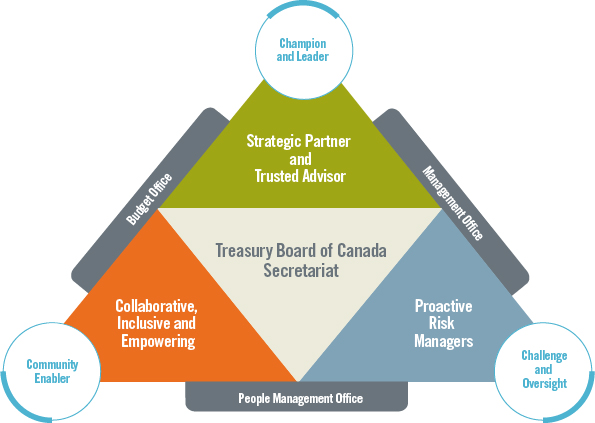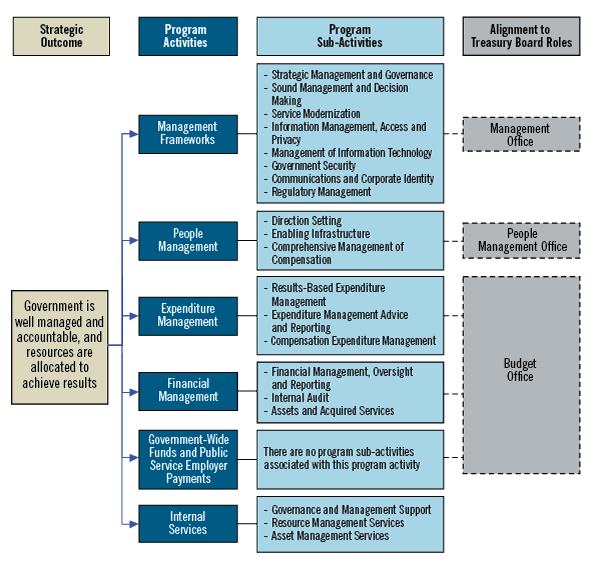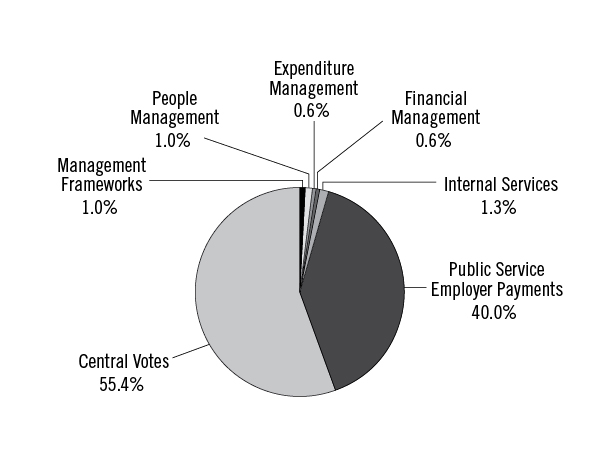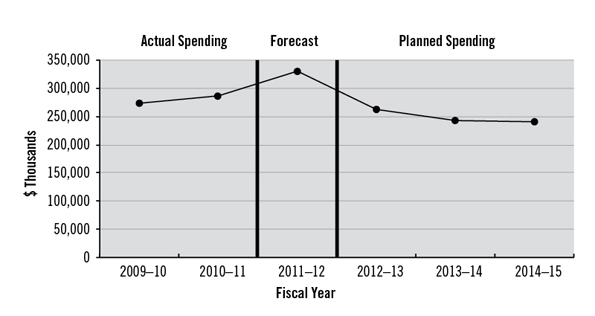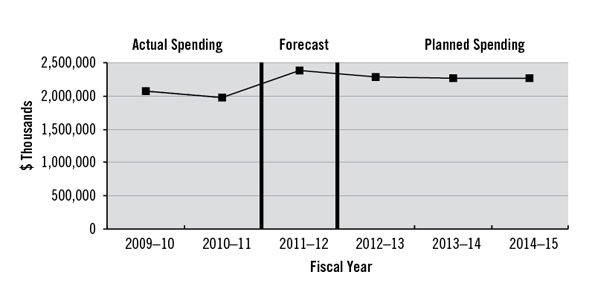Common menu bar links
Breadcrumb Trail
ARCHIVED - Treasury Board of Canada Secretariat - Report
 This page has been archived.
This page has been archived.
Archived Content
Information identified as archived on the Web is for reference, research or recordkeeping purposes. It has not been altered or updated after the date of archiving. Web pages that are archived on the Web are not subject to the Government of Canada Web Standards. As per the Communications Policy of the Government of Canada, you can request alternate formats on the "Contact Us" page.
President's Message

I am pleased to present the 2012–13 Report on Plans and Priorities of the Treasury Board of Canada Secretariat. This report supports the presentation of the Secretariat's 2012–13 Main Estimates, and sets out our priorities for the fiscal year and how we will achieve them.
The Secretariat's overarching objectives are to ensure value for money in government spending, modernize government operations, and implement a sustainable approach to effective people management.
To achieve our goals, we will work with departments and agencies to support the implementation of the government's cost-reduction and cost-containment measures. We will also ensure that our policies strengthen the consolidation of IT infrastructure and services under Shared Services Canada, as well as standardize and simplify human resources and financial-management business processes and platforms. The Secretariat will advance the Open Government initiative by developing and implementing an action plan that will enhance Canadians' access to government data and information, and support Canada's participation in the international Open Government Partnership. In keeping with our mandate to reduce red tape for business and internal to government, we will implement the small business lens and the One-for-One rule, enhance our approach to e-reporting, and further streamline our rules and policies. With our continuing focus on modernizing the public service workplace and achieving management excellence, we will support public sector organizations as they implement the new Values and Ethics Code for the Public Sector, and provide tools in support of effective workforce planning and performance in departments and agencies.
Just as the Secretariat will enable a more cost-effective approach to management across government, it will also pursue greater efficiency and effectiveness in its own operations, including streamlining and automating its internal business processes.
I invite you to read this report to see how the Secretariat continues to work to achieve better government, with partners, for Canadians.
The Honourable Tony Clement
President of the Treasury Board and Minister for FedNor
Section I: Organizational Overview
Raison d'être
The Treasury Board of Canada Secretariat (Secretariat) is the administrative arm of the Treasury Board. It supports Treasury Board ministers and strengthens the way government is managed to ensure value for money in government spending and results for Canadians.
Responsibilities
Treasury Board Roles
The Treasury Board is a Cabinet committee of ministers that oversees the government's financial, human resources and administrative responsibilities, and establishes policies that govern each of these areas. In addition, the Prime Minister has designated the Treasury Board to act as the committee of the Queen's Privy Council with respect to the consideration and approval of regulations and most Orders in Council. The Treasury Board, as the Management Board for the government, has three principal roles:
- It acts as the government's Management Office by promoting improved management performance and approving policies to support the prudent and effective management of the government's assets, financial, information and technology resources.
- It acts as the government's Budget Office by examining and approving the proposed spending plans of government departments, and reviewing the development of approved programs.
- It acts as the employer and People Management Office by setting people management policies and managing compensation and labour relations, including determining the terms and conditions of employment.
The Secretariat makes recommendations and supports the Treasury Board in each of its roles (see text box "Treasury Board Roles"). It provides advice on policies, directives, regulations and program spending to promote sound management of government resources. The Secretariat also provides leadership and guidance to enable management excellence within departments and agencies, while respecting the primary responsibility of deputy heads in managing their organizations and their roles as accounting officers before Parliament.
Within the Secretariat, the Comptroller General of Canada provides government-wide leadership, direction, oversight and capacity building for financial management, internal audit, and acquired services and assets management. The Chief Human Resources Officer leads people management across the core public administration by developing workplace and workforce policies and programs; centrally managing labour relations, compensation, and pension and benefit plans; and supporting excellence in executive leadership and management. The Chief Information Officer provides government-wide strategic direction and leadership for information management (IM) and information technology (IT), including identity management, security, and access to information and privacy.
The Treasury Board Portfolio consists of the Secretariat and the Canada School of Public Service. The Public Service Pension Investment Board, the Office of the Commissioner of Lobbying of Canada and the Office of the Public Sector Integrity Commissioner of Canada are arm's length organizations that report to Parliament through the President of the Treasury Board.
The Secretariat is guided by its vision of "better government: with partners, for Canadians." When working with federal departments, agencies and Crown corporations, the Secretariat plays three central agency roles:
- An enabling role to help organizations improve management performance;
- An oversight role that includes developing policies and standards, and reporting on the government's overall management and budgetary performance; and
- A leadership role in driving and modelling excellence in public sector management.
In recent years through the renewal of the Treasury Board policy suite and such legislation as the Federal Accountability Act, greater emphasis has been placed on the Secretariat's enabling role—helping deputy heads maximize their authorities to achieve management excellence within their organizations.
The following diagram depicts how the Secretariat works with organizations to fulfill its three central agency roles and how it supports the Treasury Board.
Figure 1. How the Secretariat Works with Organizations
Strategic Outcome and Program Activity Architecture
The following diagram outlines all of the Secretariat's program activities; these activities contribute to the achievement of its strategic outcome. The program activities collectively make up the Secretariat's Program Activity Architecture (PAA). The diagram also aligns the program activities of the Secretariat with the three main roles of the Treasury Board. The Secretariat's strategic outcome and each of its program activities are discussed in greater detail in Section II.
Figure 2. Program Activity Architecture 2012–13
Operating Environment
The Secretariat continues to operate in a complex environment characterized by ongoing global economic uncertainty, rapid technological change and an aging workforce.
In the face of ongoing global economic change and uncertainty, governments around the world are focused on returning to balanced budgets, containing growth in spending and increasing their operational efficiency. In Canada, the government has established a plan to return to balanced budgets in the medium term. Budget 2011 set the objective of achieving at least $4 billion in ongoing annual savings by 2014–15, or 5 per cent of the review base. At the same time, departments and agencies continue to implement decisions taken as part of the previous Strategic Review exercise; its implementation will continue through 2013–14. The Secretariat will continue to have an important role in enabling organizations as they implement their respective savings targets. It will also implement its own internal savings measures.
The need to reduce costs and increase efficiency presents an opportunity for government to modernize how it operates and to rethink how it delivers programs and services. The announcement of Shared Services Canada in 2011–12 was a major step toward consolidating and streamlining IT management and infrastructure, and reducing duplication across departments and agencies. Opportunities remain for further standardization and simplification of government administrative processes, including in the areas of human resources and financial management.
Modernizing government also entails the expansion of the Open Government initiative , which further enhances Canadians' access to government data and information, and creates new opportunities for dialogue. In 2011–12, Canada announced its intention to join the international Open Government Partnership to promote transparency, accountability and citizen engagement. The government continues to consult with Canadians to identify additional opportunities for open government.
Cutting red tape remains a priority for the government. In January 2012, the Red Tape Reduction Commission provided recommendations for reducing the administrative burden on small businesses that is associated with regulatory compliance. In response, the government is developing an action plan featuring a One-for-One Rule that will provide for a zero net increase in administrative burden. At an international level, the joint Canada-U.S. Action Plan on Regulatory Cooperation is helping to reduce trade barriers by aligning regulatory approaches. Work is also underway to simplify the government's internal rules and oversight processes. This includes looking at ways to streamline legislated reporting requirements and internal management policies, and provide information to Parliament in a more immediate, accessible and cost-effective way (e.g., electronic tabling of reports).
Occupational Group
Structure Review
The Secretariat is updating public service work descriptions to better reflect 21st century work and to help develop a more mobile and flexible workforce that can meet the demands of the future.
The need for fiscal restraint, coupled with Canada's aging workforce, requires a strategic, long-term approach to people management in the Government of Canada. Public Service Renewal remains a key initiative, including modernizing the workplace and adopting new tools and technologies. At the same time, the government is taking necessary steps to enhance its workforce planning to ensure that resources are well aligned to priorities and that compensation and benefits are managed in an integrated, sustainable manner over time.
Organizational Priorities
The Secretariat has identified four priority areas for 2012–15, as well as plans to support these priorities in the 2012–13 fiscal year. Plans and priorities will be supported by specific initiatives under each of the Secretariat's program activities, which are described in Section II.
| Priority 1 | Type1 | Program Activities |
|---|---|---|
| Support the government in ensuring value for money | Ongoing | Expenditure Management Financial Management |
| Status | ||
|
Why is this a priority? Ensuring value for money in government programs, services and operations is an essential component of the government's management agenda. This priority contributes to the Secretariat's strategic outcome by ensuring that government resources are effectively allocated to achieve results. Plans for meeting the priority
|
||
| Priority 2 | Type | Program Activities |
|---|---|---|
| Advance initiatives to modernize government operations | Ongoing | Management Frameworks People Management |
| Status | ||
|
Why is this a priority? In light of fiscal pressures and demographic change, there is an ongoing need to modernize how government operates in order to increase its overall efficiency and effectiveness, and to respond to the evolving expectations of Canadians. This priority contributes to the Secretariat's strategic outcome by enabling well-managed and accountable government. Plans for meeting the priority
|
||
| Priority 3 | Type | Program Activities |
|---|---|---|
| Enable a modern and sustainable approach to people management | Ongoing | People Management Expenditure Management |
| Status | ||
|
Why is this a priority? It is particularly important in a period of fiscal restraint and demographic change to adopt an integrated, long-term view of workforce planning and performance across government. This priority contributes to well-managed and accountable government by advancing a modern and efficient approach to human resources management across the core public administration. Plans for meeting the priority
|
||
| Priority 4 | Type | Program Activities |
|---|---|---|
| Pursue greater efficiency and effectiveness within the Secretariat | Ongoing | Internal Services |
| Status | ||
|
Why is this a priority? The Secretariat will continue to focus on increasing the efficiency and effectiveness of its operations. This priority contributes to the Secretariat's strategic outcome by ensuring that its human and financial resources and internal processes are optimized to support key results across all its program activities. Plans for meeting the priority
|
||
Risk Analysis
The Secretariat actively monitors its operating environment in order to identify and manage risks that could affect progress toward its strategic outcome and organizational priorities. Key risks are captured in the Secretariat's Corporate Risk Profile, which is updated at least once per year. For the 2012–15 period, the Secretariat has identified a number of key corporate risks, grouped into two categories: risks affecting the Secretariat's central agency functions and departmental risks related to its internal operations.
Central Agency Risks
The Secretariat operates in a dynamic fiscal environment. As departments and agencies work to implement a number of ongoing restraint initiatives, there is a risk that the Secretariat may not effectively enable the achievement of new and emerging fiscal objectives. This risk is most relevant to the Expenditure Management program activity.
The drive for greater efficiency creates an opportunity to accelerate the modernization of government. At the same time, the increased complexity and pace of change may challenge the Secretariat's ability to enable wide-scale standardization and consolidation of government systems and processes. This risk is most relevant to the Management Frameworks program activity.
As government seeks to strike the right balance between innovation, risk and control, adopting a simplified, risk-based approach to management oversight remains a key challenge. In recent years, progress has been made in shifting the roles and responsibilities of the Secretariat toward a greater enabling role, and in shifting that of deputy heads toward clearer accountability for the operations of departments (see "Responsibilities"). There is continued risk of a slowing down or backsliding of this shift. This risk is most relevant to the Management Frameworks program activity.
Key to mitigating central agency risks will be to maintain an ongoing dialogue with deputy heads and functional communities to anticipate issues and develop timely responses, advice and tools in support of achieving fiscal objectives and government modernization. The Secretariat will also take a more integrated approach to collecting and managing data about departments and agencies to enable integrated analysis, monitoring and enhanced decision making. It will continue to review and propose adjustments to the suite of Treasury Board policies to minimize unnecessary administrative burden and embed risk-based decision making across management functions.
Departmental Risks
Cyber Security
The Secretariat recently implemented a layered defence strategy to protect its IT infrastructure. This included consolidating its data centres and increasing security measures for its computers and servers. In addition, all employees will now receive mandatory security awareness training and real-time compliance monitoring.
The Secretariat has identified risks to its internal operations, including its ability to ensure business continuity in emergency situations and to respond to ever-present cyber threats to its data and information. With the creation of Shared Services Canada, the Secretariat is also managing risks around the transition to a new government-wide approach to managing certain IT services and infrastructure; it has created an internal project team to enable a smooth transition and mitigate any risks to its internal IT services. Further, the Secretariat is managing risks around the transformation and sustainability of its operational processes and systems following successive resource reductions resulting from government cost-containment measures. These departmental risks are relevant to the Internal Services program activity (see "Program Activity 6: Internal Services" in Section II).
Strategies to mitigate departmental risks include implementing and monitoring the plans for Departmental Security, Disaster Recovery, Emergency Management and Business Continuity, as well as regularly engaging employees to improve security awareness and emergency preparedness. The Secretariat will also leverage its integrated business planning process to ensure that resources and internal support services are aligned to the highest priorities and that spending is closely monitored.
Planning Summary
Financial Resources2
This table presents a summary of the total planned financial resources for the Secretariat for the next three fiscal years.
| 2012–13 | 2013–14 | 2014–15 |
|---|---|---|
| 262,944 | 243,796 | 240,544 |
| 2012–13 | 2013–14 | 2014–15 |
|---|---|---|
| 5,430,433 | 5,420,474 | 5,411,574 |
Human Resources
This table presents a summary of the total planned human resources for the Secretariat for the next three fiscal years, presented as the number of full-time equivalents (FTEs).
| 2012–13 | 2013–14 | 2014–15 |
|---|---|---|
| 2,066 | 1,926 | 1,921 |
Planning Summary Tables
| Performance Indicators | Targets |
|---|---|
| Canada's ranking in The World Bank Worldwide Governance Indicators, Indicator 3, "Government Effectiveness." | Top 10 among Organisation for Economic Co-operation and Development member countries (annually). |
| Program Activity | Forecast Spending 2011–12 |
Planned Spending | Alignment to Government of Canada Outcomes | ||
|---|---|---|---|---|---|
| 2012–13 | 2013–14 | 2014–15 | |||
| Management Frameworks | 80,181 | 59,741 | 50,480 | 50,031 | Government Affairs: Well-managed and efficient government operations. |
| People Management | 66,715 | 59,431 | 53,768 | 51,772 | |
| Expenditure Management | 56,324 | 35,295 | 35,295 | 35,295 | |
| Financial Management | 35,018 | 32,912 | 32,532 | 32,532 | |
| Government-Wide Funds and Public Service Employer Payments | 4,164,299 | 5,430,433 | 5,420,474 | 5,411,574 | |
| Total Planned Spending | 5,617,812 | 5,592,550 | 5,581,204 | ||
| Program Activity | Forecast Spending 2011–12 |
Planned Spending | ||
|---|---|---|---|---|
| 2012–13 | 2013–14 | 2014–15 | ||
| Internal Services | 91,796 | 75,564 | 71,721 | 70,914 |
Cost Containment
The Secretariat is undertaking measures to increase its operational efficiency and reduce costs. These include adjustments to address the freeze on departmental operating budgets at 2010–11 reference levels, which was announced in Budget 2010; ongoing implementation of the results of the Secretariat's 2010 Strategic Review announced in Budget 2011; and its contribution to the creation of Shared Services Canada.
Operating Budget Freeze
The Secretariat is implementing the last year of the three-year freeze on departmental operating budgets announced in Budget 2010. Through its implementation of a three-year Strategic Financial Plan in 2011–12, the Secretariat can now incorporate in one document the financial impact of government-wide expenditure restraint measures, including the impact of the operating budget freeze. In addition, through its quarterly financial reviews, it continues to regularly monitor spending to ensure it operates within allocated resources. The Secretariat is monitoring staffing and attrition more closely and, where necessary, may not fill all vacated positions. It also continues to implement measures to maximize operational efficiency and productivity, such as streamlining business processes and reducing travel and hospitality costs, wherever possible.
Strategic Review
In 2012–13, the Secretariat will continue to implement its 2010 Strategic Review results, which identified $11.5 million in savings, representing 6 per cent of its budget. The Secretariat successfully met its $4.9 million savings target for the first year of implementation (2011–12). It is ahead of schedule for meeting its savings targets for the remaining two fiscal years, having already implemented 72 per cent of the $9.7 million target for the cumulative period ending in 2012–13 and 63 per cent of the $11.5 million target for the cumulative period ending in 2013–14. These efficiencies are being realized across the department by eliminating lower priority activities, reducing discretionary activities, and streamlining and consolidating internal processes and resources.
Shared Services Canada
The Secretariat has also been supporting the creation of Shared Services Canada, which was established by an Order in Council dated November 16, 2011. Cost savings will be achieved through the consolidation and centralized delivery of government IT services (i.e., email, data centre and network services). In 2011–12, the Secretariat contributed $4.3 million (net of revenue) to the creation of Shared Services Canada, including the transfer of 45 positions. It is also providing advice on the establishment of this organization's internal management functions. In 2012–13 and ongoing, the Secretariat will provide $10.6 million (inclusive of the employee benefit plan) to Shared Services Canada as a result of responsibilities transferred to the new organization.
Contribution to the Federal Sustainable Development Strategy
The Federal Sustainable Development Strategy (FSDS) outlines the Government of Canada's commitment to improving the transparency of environmental decision making by articulating its key strategic environmental goals and targets. The Secretariat ensures that consideration of these outcomes is an integral part of its decision-making processes. In particular, through the federal Strategic Environmental Assessment (SEA) process, any new policy, plan or program initiative includes an analysis of its impact on attaining the FSDS goals and targets. The results of SEAs are made public when an initiative is announced, demonstrating the department's commitment to achieving the FSDS goals and targets.
The Secretariat contributes to Theme IV of the FSDS, Shrinking the Environmental Footprint – Beginning with Government, as denoted by the following visual identifier.
This contribution is a component of the Internal Services program activity and is further explained in Section II.
For additional details on the Secretariat's activities to support sustainable development, please consult the Secretariat's website. For complete details on the FSDS, see the Environment Canada website.
Expenditure Profile
For fiscal year 2012–13, the Secretariat's total available funding in the Main Estimates is $5.69 billion. This includes centrally managed funds, in the amount of $3.15 billion, used to supplement the appropriations of other departments. The Secretariat's planned spending excluding centrally managed funds is $2.54 billion.
The majority of the planned spending ($2.28 billion) is related to the Secretariat's role as employer of the core public administration. These funds are used for the following:
- The public service pension, benefits, and insurance, including payment of the employer's share of health, income maintenance, and life insurance premiums;
- Payments to, or in respect of, provincial health insurance;
- Payments of provincial payroll taxes and Québec sales tax on insurance premiums; and
- The return to certain employees of their share of the employment insurance premium reduction.
The remaining planned spending ($0.26 billion) is directly related to the operations of the Secretariat and to the five following program activities: Management Frameworks, People Management, Expenditure Management, Financial Management, and Internal Services.
Figure 3. 2012–13 Planned Spending (Total $5.69 billion)
Departmental Spending Trend
The following figure illustrates the Secretariat's spending trend from 2009–10 to 2014–15 for the operations of the Secretariat and the five following program activities: Management Frameworks, People Management, Expenditure Management, Financial Management and Internal Services. These operations reflect the people and activities that support the Secretariat's strategic outcome of ensuring that government is well managed and accountable and that resources are allocated to achieve results.
Figure 4. Spending Trend for Program Expenditures (Vote 1)*
*Includes Employee Benefit Plan
The Secretariat's spending increased in 2011–12 compared with 2010–11, largely due to the funding received to implement the following initiatives:
- Resources for external experts who will help design a framework for the Strategic and Operating Review based on public and private sector best practices, to achieve operational and administrative efficiencies;
- Paylist expenditures, primarily for one-time severance payouts stemming from the provisions of new collective agreements;
- Support for a litigation management unit within the Secretariat to manage employment and labour relations litigation;
- Red Tape Reduction Commission;
- Completion of the project that rationalized the unique system-sharing needs of the Secretariat and the Department of Finance Canada; and
- An initiative to modernize human resources government-wide.
These increases were offset by reductions through the implementation of Strategic Review decisions, cost-containment measures and sunsetting initiatives.
The Secretariat's spending will decrease between 2012–13 and 2014–15, mainly due to the sunsetting of funds and the implementation of Strategic Review decisions and cost-containment measures.
Figure 5. Spending Trend for Public Service Insurance (Vote 20)Expenditures for public service insurance include the payment of the employer's share of contributions required under the various insurance plans sponsored by the Government of Canada. It also represents payments for taxes, a number of employer obligations, and other expenses.
Public service employer payments increased from 2010–11 to 2011–12 as a result of growth in the public service and growth in the government-wide wage envelope and the cost of benefits under the plans. Planned spending for public service insurance is decreasing from 2011–12 to 2012–13 in the amount of $103 million. The decrease is primarily due to cost savings from the successful introduction of a pay direct card for the Public Service Health Care Plan and lower growth in membership. Although planned spending from 2012–13 to 2014–15 is relatively stable, it is premature to draw trend conclusions at this time.
Estimates by Vote
For information on our organizational appropriations, please see the 2012-13 Main Estimates publication.

